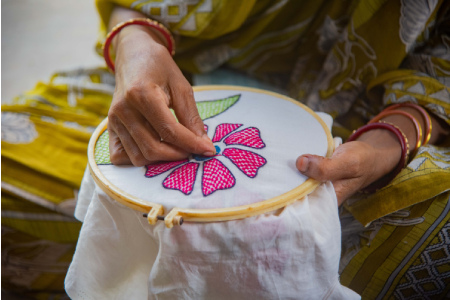
In this embroidery tradition, rural women reuse old worn out clothes and create something new and extraordinary. Kantha epitomizes recycling and sustainable fashion in today’s day and age. More than recycling or reusing clothes, the value of keeping something that has travelled through generations and signifies family heritage becomes important. The women embroider beautiful motifs that speak stories of the family, the community, and the dreams and aspirations of the women on the clothes using Kantha. While traditionally it was a leisurely pursuit, at present Kantha weaving has reached new heights, where the practicing artists have transformed Kantha weaving into a profession from passion and are transcending boundaries to present their art form to varied range of national and global audience. Under the purview of RCCH project, at present over 3600 women from rural Bengal are actively pursuing kantha weaving and redefining the art form through their aesthetic imagination. A pattern of Bengal’s Kantha, known as ‘Nakshi Kantha’ has been accredited with the tag of Geographical Indication (GI).
The Kantha tradition was widespread in undivided Bengal, cutting across social, economic and religious norms and the technique, process and aesthetics of this ‘utilitarian’ textile have ancient roots. The visionary, thinker, philosopher and poet Tagore who wrote movingly about Lord Buddha’s renunciation in his poem Ebar Phirao More, refers to the young prince Shiddhartha as one with only a Chinna Kantha (tattered Kantha) leaving his kingly home in search of his ultimate truth shorn of all his princely garments and material possessions. Among the Muslims too, Sufi saints and the dervishes including the Baul singer Lalon Fakir- so revered in undivided Bengal- were known to use layered and quilted Kanthas as attire. The Baul singers refer to Kanthas in their mystical music as a metaphor for their spiritual wanderings free from material ties. In one of his Baul Gaan or songs Lalon Fakir says, “Lalon sainer chera kantha gaye dile ki sit mane” Can Lalon’s tattered Kantha keep this cold away? Replete with such spiritual undertones the Kantha was naturally seen as a symbol of an ascetic’s surrender of material ties. Other early references in folk songs and verses indicate that the Kanthas reworking of old fabrics into a new object was viewed as a symbolic enactment of the cycle of life and its affirmation of rebirth and revival.



